Machu Picchu has always been my dream destination to visit:
There’s something about the accurately-fitted ruins with much historical significance, the engineering genius in accordance to the sun and moon and it being hidden in the clouds that makes it so mystical.
I once had a photoshopped picture of myself holding my selfie stick in front of the famed postcard photo of Machu Picchu. That’s how much I wanted to visit it.
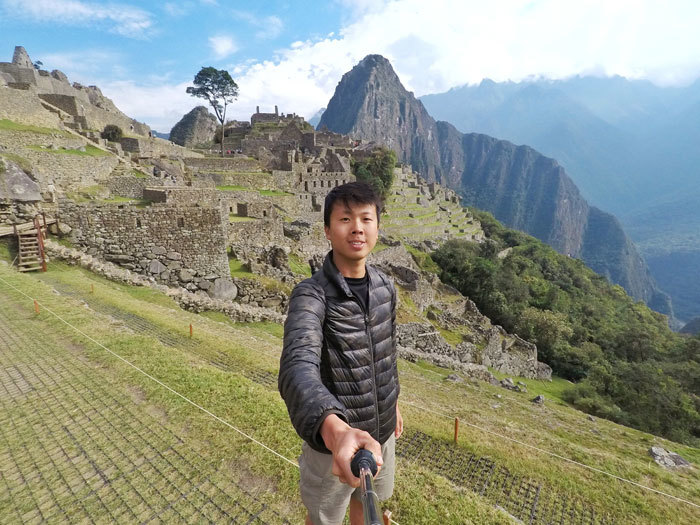
One would’ve thought I’d rush to visit the New Wonder of the World the moment I arrived in Cusco, but it was only almost 3 weeks later that I took the plunge and went on a 5-day Salkantay pilgrimage to Machu Picchu.
I wanted the experience to be as perfect as possible and I guess subconsciously, I was worried that it wouldn’t live up to the hype and image that I built up in my mind.
I shouldn’t have worried at all.
Alternative to the Inca Trail
Sure, the history lover in me would love to go on the Classic Inca Trail and experience the same journey the Incas took, immersing in history and culture, but requiring me to book 6 months in advance is out of the question.
Travelling long term means changing itineraries often - I never knew when I’d arrive in Peru. Plus, the price of the Inca trail is out of my backpacker budget. (My friend did it, and here's what you need to know about the Inca trail.)
The next best option for me would be the Salkantay Trek – once named the Top 25 Treks in the World by Nat Geo Travel.
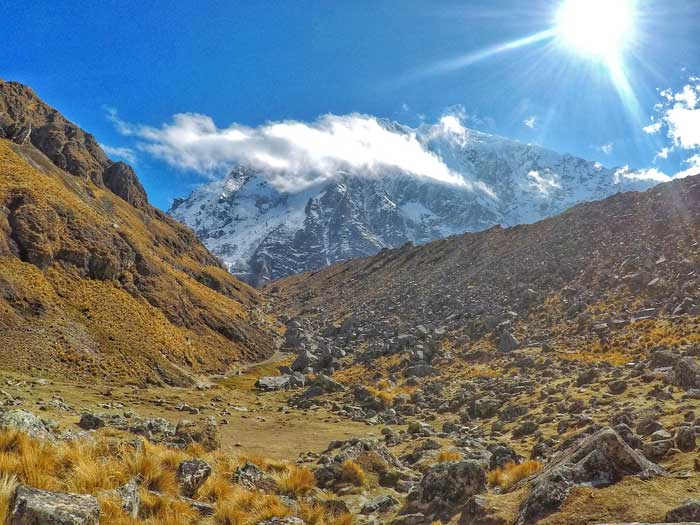
The 5-day Salkantay Trek takes you through some of Peru’s mighty mountains, varied valleys, fertile forests and roaring rivers. It takes you through steep uphill climb and knee-busting downhill walks. But best of all, it brings you to local mountain villages and reconnects you to Mother Nature.
Unlike the Inca Trail, no permit is required for the Salkantay Trek. You can book it the day before your trek when you arrive in Cusco. It is waaaay cheaper and has way fewer people than the overcrowded Inca Trail.
- YOU MIGHT ALSO LIKE: Hiking Up Mount Roraima in Venezuela
Here is my experience:
The 5-Day Salkantay Trek to Machu Picchu
DAY 1: CUSCO – MOLLEPATA – SORAYPAMPA (HUMANTAY LAKE)
I waited at Cusco’s Plaza de Armas at 4:30 am for the bus. Cusco has a strange twilight crowd: Partygoers were spilling out of bars and clubs and slumping into the taxis, while trekkers were waiting for an early-morning tour.
3 hours later, the bus arrived at a small village named Mollepata (2900m) where we had breakfast (not included), weighed and passed our allowed baggage (5kg) to the horsemen and had our first introductions to the group.
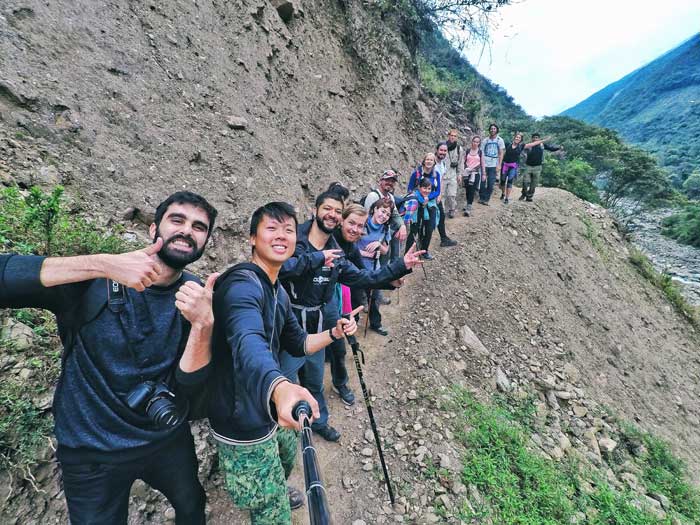
It was a massive and diverse group – 17 people from five different continents, 2 guides, 4 chefs/helper and a horsewoman. I usually dislike big groups but this was more fun than I expected. I spoke 3 languages while on the trek.
We took a short bus ride to our starting point for a relatively leisurely walk alongside deep green valleys and snow-capped mountains while our guide Clima introduced the different Andean bushes.
We arrived to the campsite Soraypampa (3900m) to have our tents all set up just in time for lunch and nap. At 3900m, the campsite is cold and the warm lunch and soup was a welcome relief.
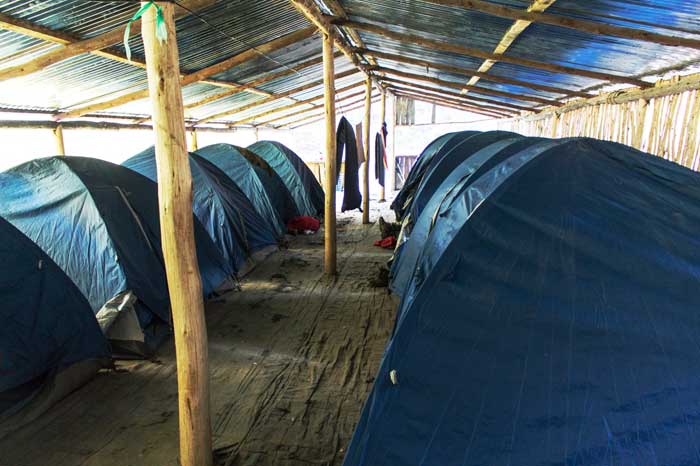
Photo: Victor Belloti
After a short siesta, our entire spontaneous group decided to hike up to the Humantay Lake, 1 hour from the campsite. It was windy and cold but the heat generated from the steep hike up to the 4600m lake kept us warm.
Humantay Lake is one of those places where I saw on the internet and I knew I had to go. It blew me away in photos and it blew me away on first glimpse.
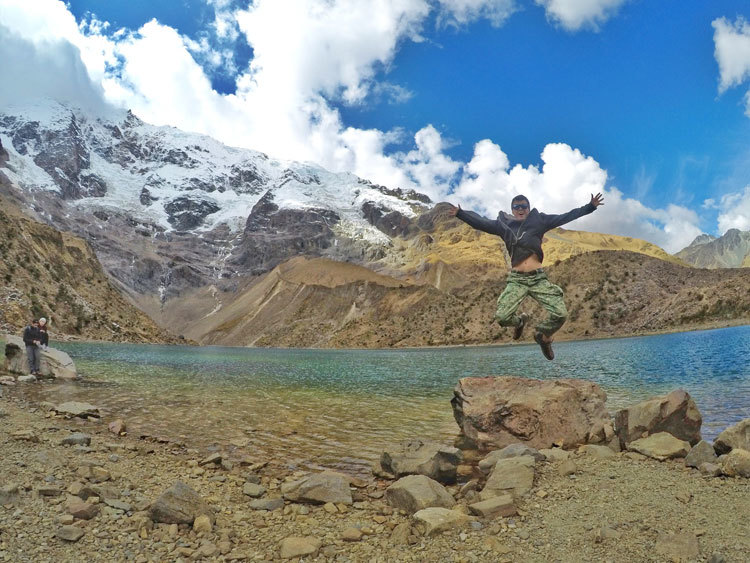
The lake at the feet of the majestic Humantay Mountain had crystal blue water, which sparkled when the clouds parted and revealed the sun.
The adventurous ones climbed up to the narrow ridge above the lakes and admired the view from above. On one side of the crater-like ridge is the gorgeous lake, on the other is a great field plain with cows feeding.
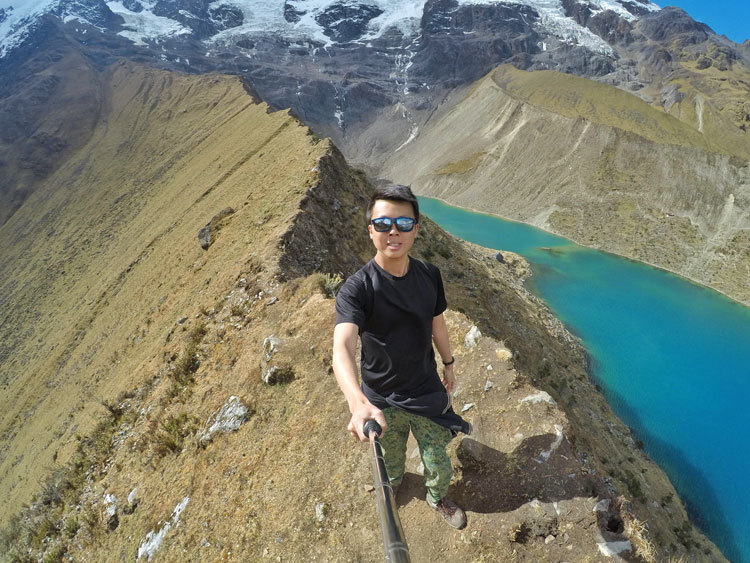
The winds battered us relentlessly that I had to retreat to the campsite.
A quick happy hour (of biscuits and hot beverages) and dinner later, we had an early night at 8pm in preparation for the supposedly ‘toughest second day’.
Night came quickly in the mountains and stars filled the skies.
DAY 2: SORAYPAMPA – SALKANTAY PASS – CHAULLAY
“Coca tea! Coca tea!”
The chefs screamed knocked on our tents with hot cups of coca tea at 5 am, a room-service we did not look forward to for the next 3 days. It was impossible to stay asleep with that ruckus they made every morning.
I had a good sleep even though the temperature was freezing. The tent, sleeping bag and paper-thin sleeping mat was surprisingly sufficient.
After a breakfast of pancakes, group warm-up (yes lol) and briefing by our guides, we set off on the hardest day of the trek.
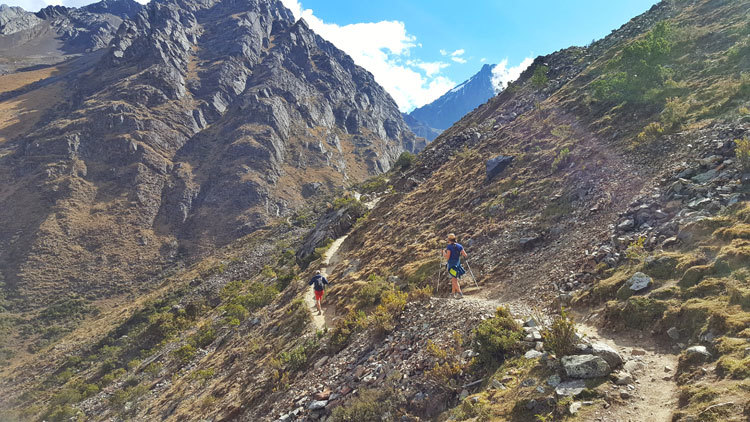
The first part to Salkantaypampa campsite (4100m) - our first rest stop - was just a warm-up for the actual road ahead: a series of seven uphill switchbacks on scree and loose rocks. Some call it the ‘snake’.
Clima calls it the Gringo Killer. He described the trek as alternating between ‘Gringo Killers’ and ‘Inca Flats’. This part is known as the hardest of the entire trek; some Salkantay Trek t-shirts even has a ‘I completed the 7 Snakes’ tagline.
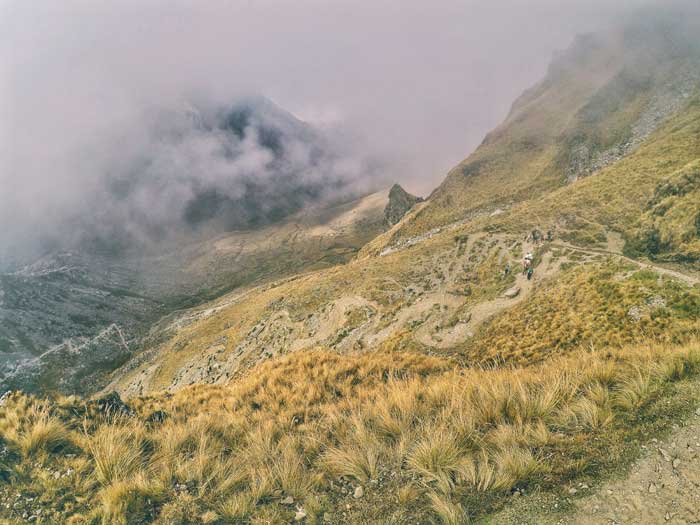
Two ladies from my group opted to ride the horse up. I don’t judge; everyone should know their bodies. I quit a trek halfway back in Chile.
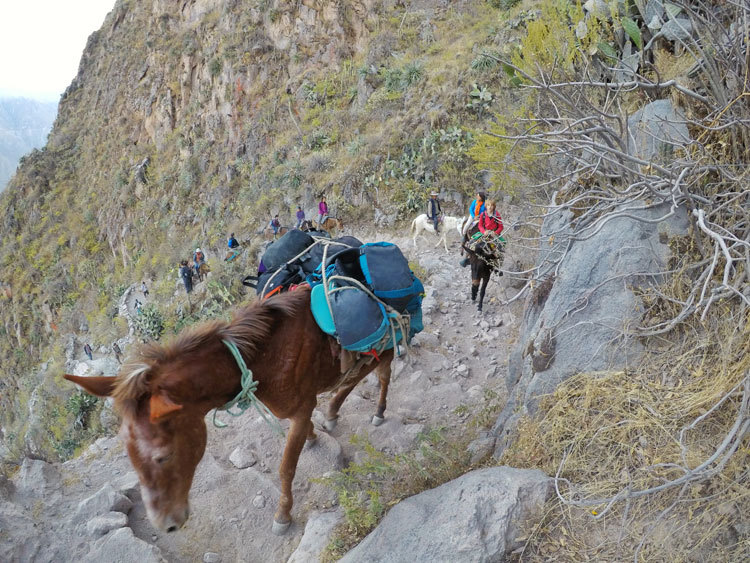
As I took my first step up the hill, I just kept telling myself to keep fvcking going. I put one foot in front of the other without stopping and sooner than I expected, I reached the top.
As if like a reward, the view up there of the valleys we just crossed, the clouds-covered mountains and just about everything was breath-taking (literally).
Breakfast to lunch was almost 8 hours apart and I was glad I brought energy bars along. We stopped for a snack-break before climbing to the highest point of the 5-day trek.
The highlight of the Salkantay trek is to be able to walk in the shadows of the mighty Salkantay Mountain (6240m), the second highest in the Cusco region, and a scared site.
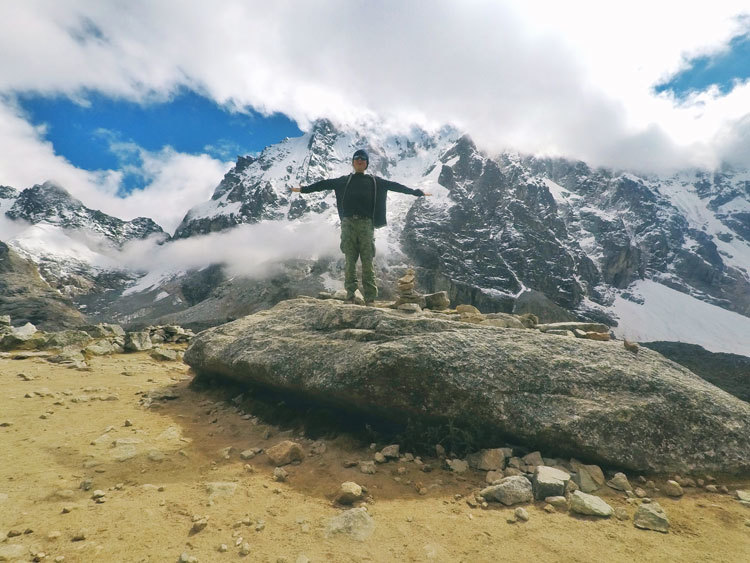
After having done (and struggled) the Rainbow Mountain hike at 5000m, nothing seemed too tough for me. Climbing up to the Salkantay Pass (4630m, the highest point of the trek) was surprisingly easy for me.
We waited for everyone, took some group photos and congratulated each other for overcoming the toughest part. Our guides then offered us a detour to the nearby Salkantay Lake.
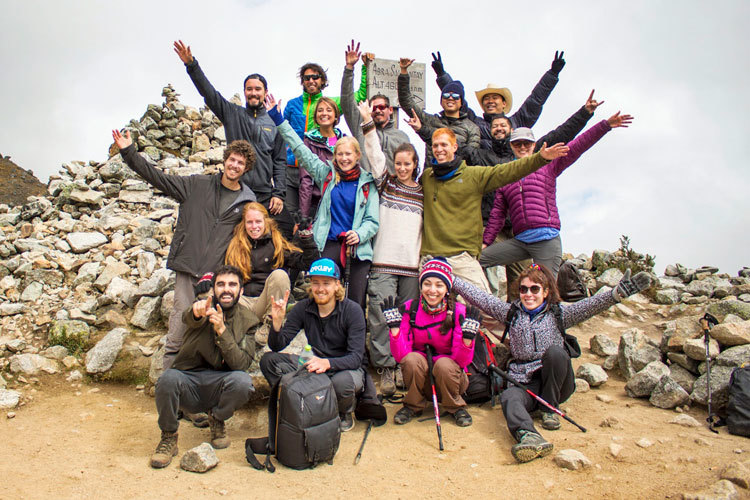
Photo: Victor Belloti
To get there, we had to step over different-sized rocks jutting out at all angles. The Salkantay Lake was not as pretty as the Humantay Lake, but the milky blue of the glacier water was an interesting sight to behold.
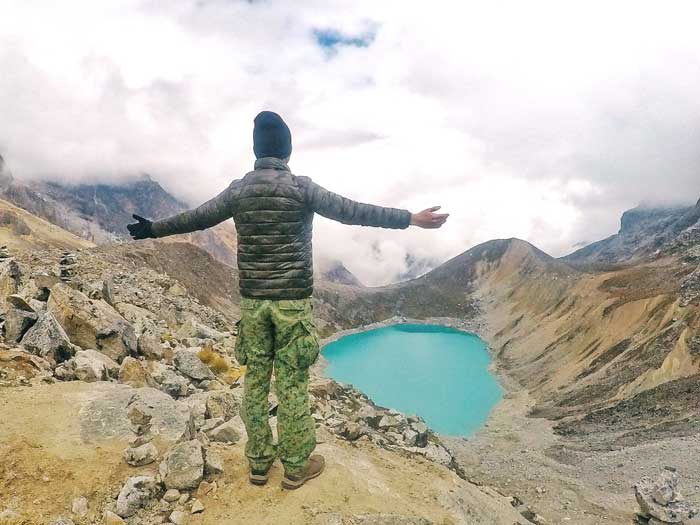
We were ahead of time, so Clima went into storytelling mode. We gathered around him like kids around a teacher telling stories.
Salkantay in Quechua means ‘Wild’ or ‘Savage Mountain’. Not many succeeded in climbing to the peak of the avalanche-filled mountain.
He also briefly shared about the history of Machu Picchu and the Spanish conquest but that’ll be another post for another day. 🙂
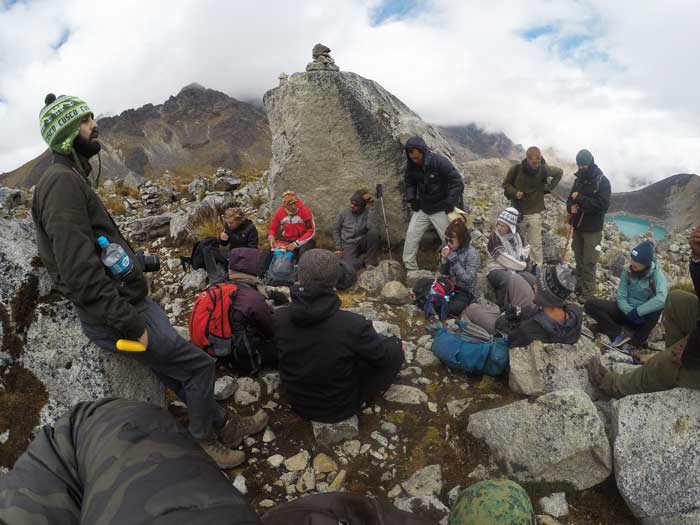
5km of pure downhill hike over gravel path and hardened mud later, we arrived at a small campsite for lunch. Everyone walked at different speed but we were united when it came to lunch.
We waited almost an hour for our injured friends to arrive before digging in to the delicious fried chicken fried rice. The hungrier we got, the better the food tasted. Yum.
From here, it was an onwards descend into the mosquito-infested ‘cloud forest’. From high alpine mountains and valleys to the green amazon rainforests, it’s amazing how the climate and terrain could change so much in a short time.
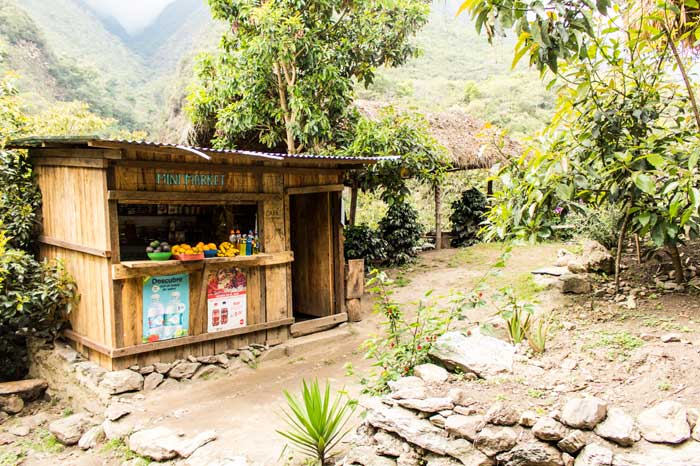
Photo: Victor Belloti
After almost 9 hours of trekking, we arrived at our campsite at Chaullay Village (2900m). Even though cold showers were available here, most of us decided to stay dirty and opted for a beer instead (I did not).
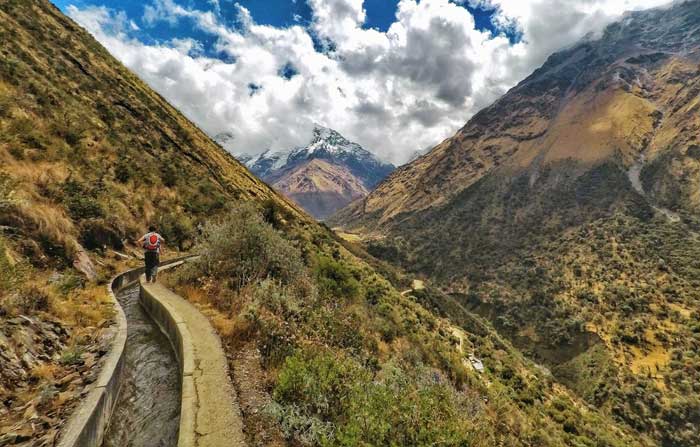
Having been acclimatised to the highlands since San Pedro in Chile and a whole month in Bolivia - plus Cusco being at over 3000m - it’s funny how at 2900m, it was ‘low altitude’ and ‘warm’ for us.
A game of cards, a happy hour and a good dinner later, we had our well-deserved sleep.
DAY 3: CHAULLAY – LA PLAYA – SANTA TERESA
We woke up to a change in scenery. Gone were the snow-covered peaks, replaced by towering green trees. We walked by the cliffside, accompanied by the sound of the flowing river.
Clima stopped frequently to talk about the native plants; hallucinogenic bell-shaped flowers to durable Andean grass to colourful mountain berries. We even had a local passionfruit called granadilla for snack break. (To open it, just crush it on your head.)
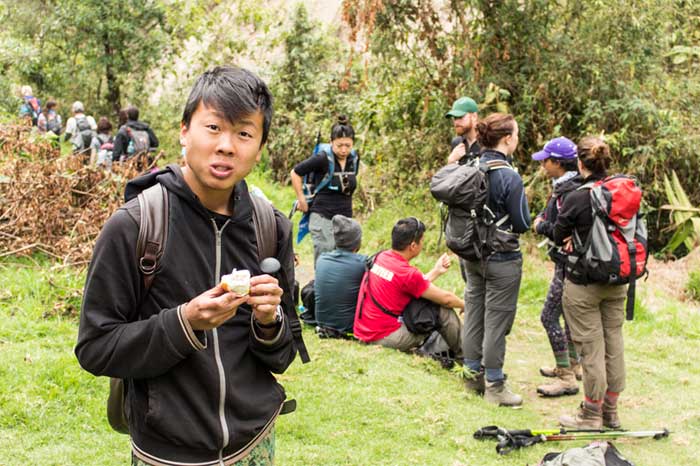
Photo: Victor Belloti
The third day was the most relaxed day of hiking; a constant descent all the way. By lunch time, the sun and change in elevation made it a hot and humid day.
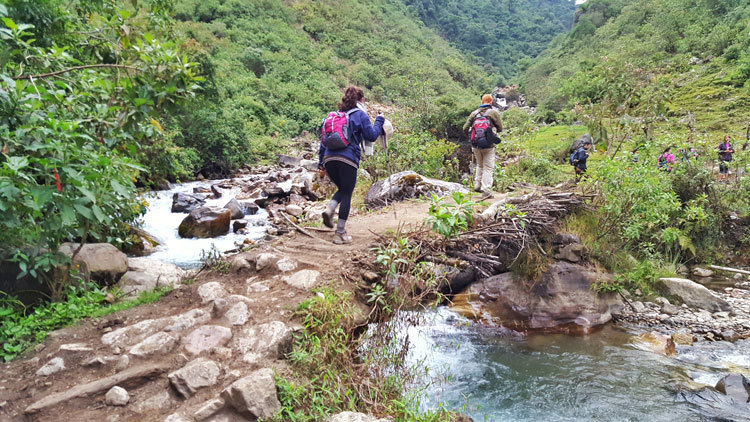
We had such a long lunch break that the guides and local people started to play a traditional Peruvian game: throwing coins into a golden frog’s mouth. (It is extremely difficult.)
A short hike after lunch got us to the end of the trail where we soaked our tired legs into the cool running river.
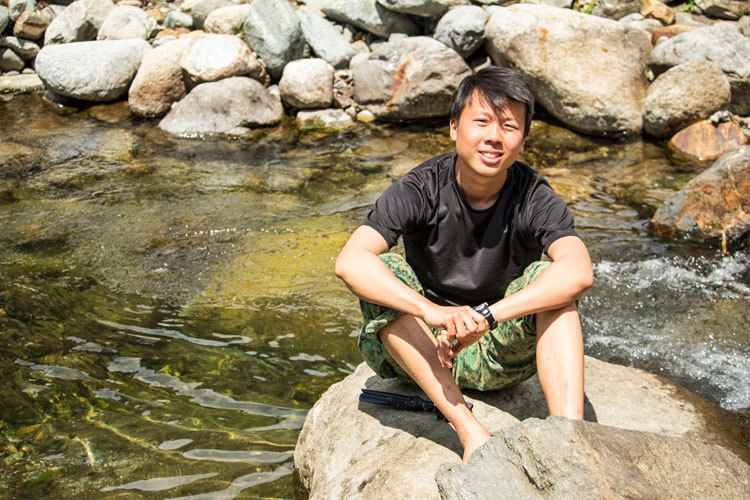
Photo: Victor Belloti
We then boarded our party bus to the campsite at Santa Teresa (1900m). Hiking for day three was over. In fact, hiking for the Salkantay Trek is kinda over. The next two days to Machu Picchu isn’t technically ‘the Salkantay Trek’.
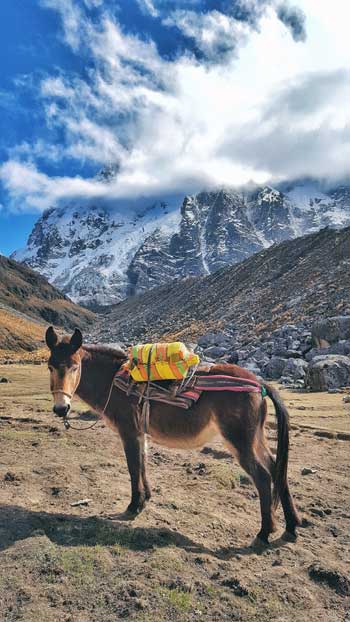
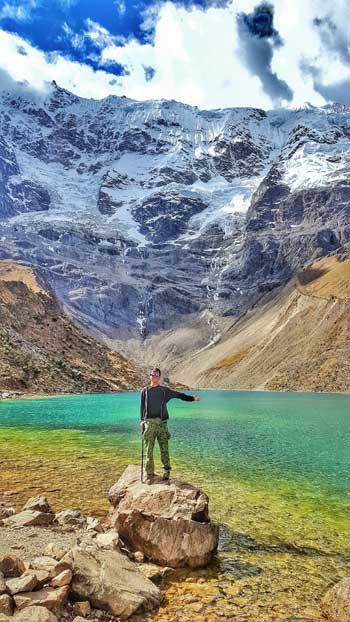
But the day wasn’t over. The night was still young. Very young.
An optional trip to the hot springs at Santa Teresa town is included in most Salkantay (and other) treks. The guides arranged a bus ride at an exorbitant cost of PEN $15 (USD $5) per pax, and the entry to the hot springs is an additional PEN $10 (Sep 2017).
The alternative is to walk the 1 hour there or find a moto-taxi in town. Our group was huge and communication sometimes was a challenge, and we all ended paying the PEN $15. Sadly.
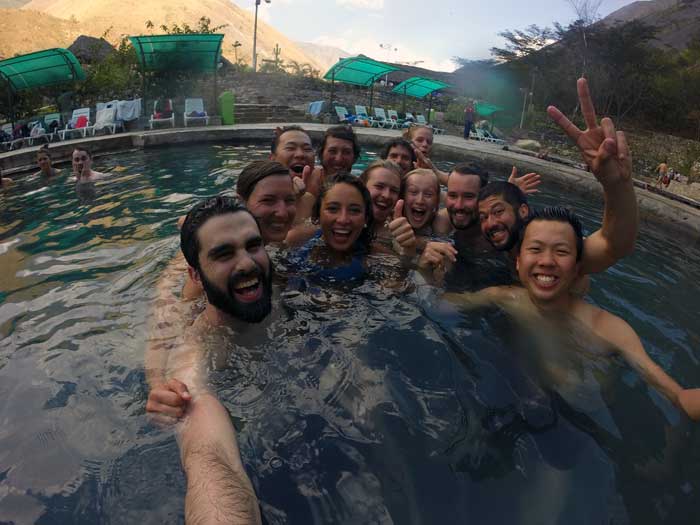
The hot springs were overcrowded with dirty hikers and the water wasn’t hot at all. It was a disappointment, just like the one at the Colca Canyon. Nevertheless, we appreciated the chance to relax our aching muscles and took refuge from the swarms of ferocious bugs hungry for human blood.
After dinner at the campsite, the locals started a campfire and with music and a bar with PEN $1 tequila shots (Inka Tequila), all hell went lose.
The tequila was potent. It seemed like people hardly partied with an Asian guy and I was fed tequilas constantly. Coincidentally, two of my group members were expecting their birthdays so a handful of us partied till 12am.
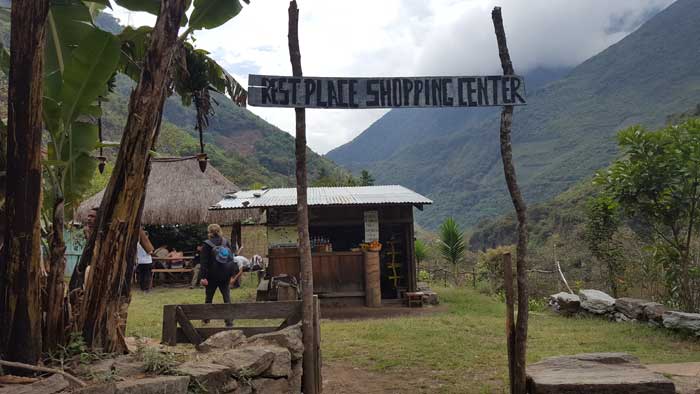
Needless to say, I got wasted. I had a blast of a time (probably the most fun I had in South America), but I got SO wasted the next morning.
DAY 4: SANTA TERESA – (ZIPLINE) - HIDROELECTRICA - AGUA CALIENTES
I woke up feeling like shit.
I puked the night before and I puked the morning after. It was so ironic because the catalyst for me signing up for the Salkantay Trek was to get away from the party scene in Cusco and to reconnect with nature.
Yet this was the most wasted I felt on my whole trip.
Lesson learnt: If you’re trekking, avoid the PEN $1 (USD $0.30) tequila shots. Unless it’s your friends’ birthday,
Half of us walked to Hidroelectrica, the other half went for the highest ziplining in South America. It costs PEN $100 for 5 ‘flights’ and I somehow survived the ziplining while I was hungover.
I was so afraid I would puke while zooming across the beautiful valleys.
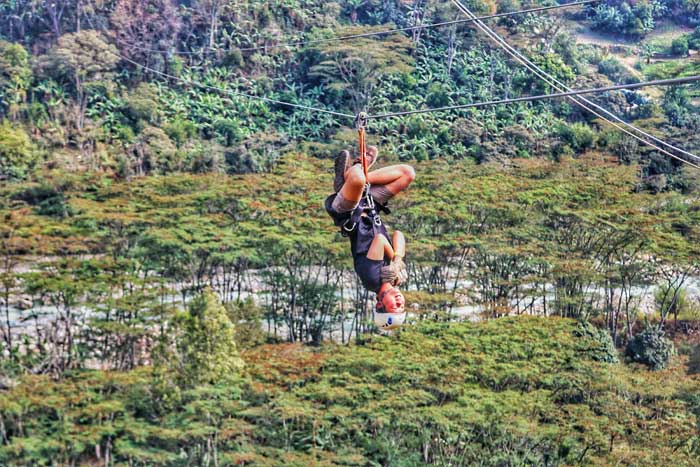
Another tragedy struck here: I wore shorts and I got raped by the hundreds of flies here. My legs became a spectacle for the thousands of tourists in Machu Picchu. I had to choose between hiking the hot weather in long pants or exposing my legs to the flies. The drunk me made the wrong choice.
It was the longest, most painful, and hungover walk from Hidroelectrica (our lunch spot) to our destination - Aguas Calientes.
We walked along the train trek for 3 hours - where the rich and mighty laughed at us poor fellows from the comfortable train seats. Or maybe, it was just my imagination.

The path was flat but it was covered entirely by stones and gravel. This wins the title of ‘Blisters Factory’. It was amusing to see everyone balancing on the wooden planks and switching lanes whenever there was an opening on the ground without rocks, however short the path was.
The walk was terrible but the view was great. A river flowed beside us while mountains surrounded us. Halfway in, we caught our first glimpse of Machu Picchu atop the mountain it was sitting on. An extremely small sight, but it rejuvenated us.
That is our destination.
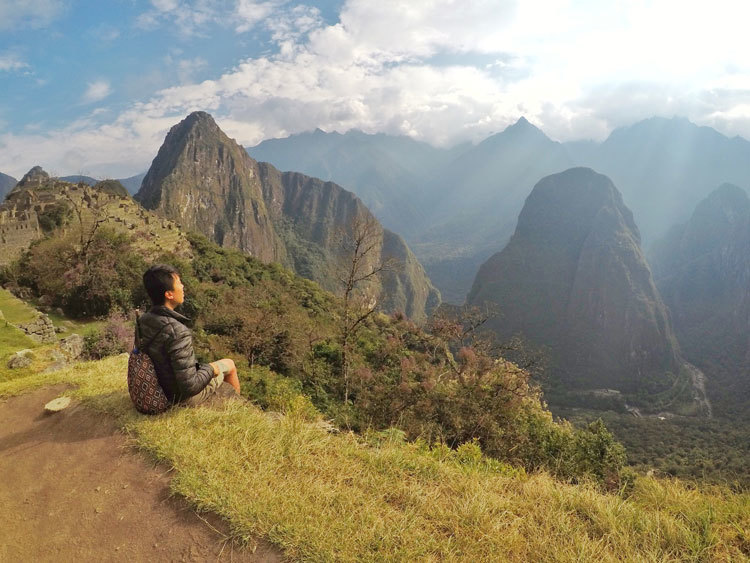
The ordeal was replaced by relief and excitement as we stepped on the roads of Aguas Caliente, the Machu Picchu town.
It was here where we had our first warm shower in 4 days, a comfortable bed and food at a proper restaurant. We also went out for beers to celebrate the last moment of Victor’s birthday. (I did not have any more alcohol.)
The prices in Aguas Caliente are high, with a 20% tourist tax. But considering that it serves purely for tourists visiting Machu Picchu, it is no surprise.
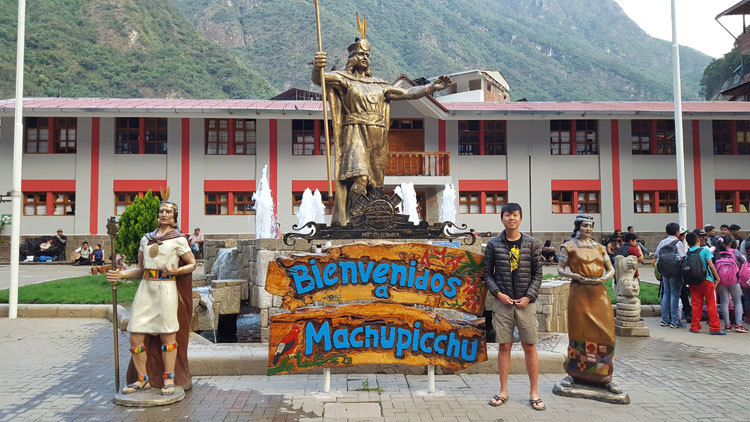
I was tempted to have a massage but with the thousands of insect bites on my legs (even I felt disgusted), I went to bed early instead.
DAY 5: MACHU PICCHU!
We woke up at 3:30am and by 4, we left the hostel. It was the earliest of the 5 days.
A queue had already formed at the bridge to the access point for the steps up. At 5am, the gates opened and we began our 1 hour climb up the gruelling steps.
This last stretch of around 2000 steps was the toughest part of the whole trek for me. I stopped multiple times to catch my breath, to stretch my legs and to slap the pussy shit out of me.
The alternative is to pay USD $12 for a 30 min’ bus ride from Aguas Caliente to the entrance of Machu Picchu. But after 5 days of trekking, do I really want to ‘cheat’ my way up?
All the way, man, all the way.
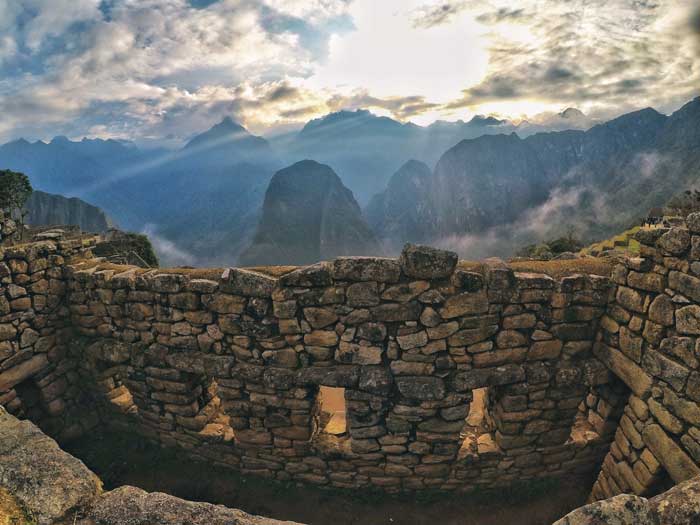
The gates opened at 6am, the sun started rising and as I stepped into my dreamland, I couldn’t help but felt the surrealism of it all.
5 days of hiking in the alpine mountains, the rainforests, bitter-cold nights, warm afternoons, insect bites and getting drunk, I was finally here.
Machu Picchu – one of the New Wonder of the World. My number one destination in South America. My dream, came true.
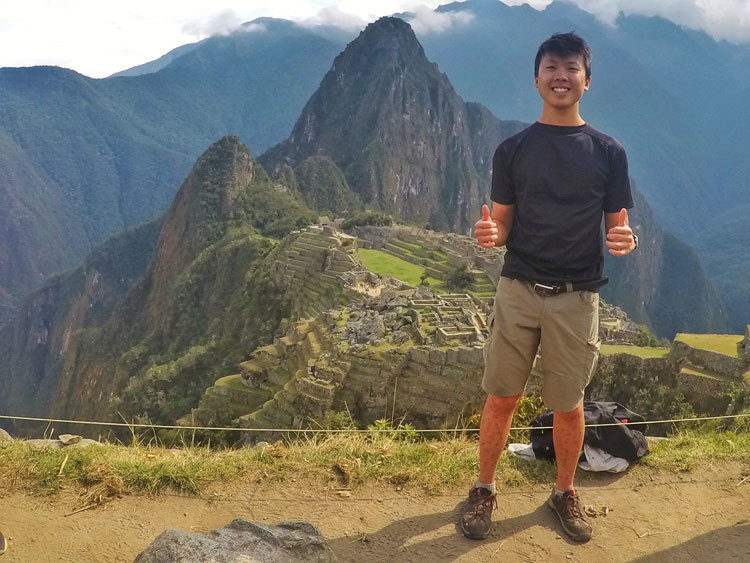
Doing the Salkantay Trek instead of taking the train and buses felt like a pilgrimage to the sacred site and it felt way more rewarding for me.
I would talk about Machu Picchu but that would be another post by itself. And besides, words can’t describe its majesty for me.
After a roughly 2 hour guided tour, we had the rest of the morning to explore the ruins by ourselves.
- YOU MIGHT ALSO LIKE: Santa Cruz Trek in Huaraz, Peru
DAY 5 PART 2: MACHU PICCHU – HIDROELECTRICA – CUSCO
Guess what?
The trek doesn’t end at Machu Picchu.
The bus down costs USD $12 too and at this point, it was extremely tempting for us, but we walked the 2000 steps down instead. Our knees were mostly destroyed by now and each step was a painful struggle.
Then we had to walk back the stretch of ‘Blister Factory’ train track to Hidroelectrica. The sun was at its strongest at noon and it didn’t make the return journey any better.
After lunch at Hidroelectrica was our last obstacle: a 6 hours’ cramped bus ride back to Cusco.
That’s what you get for going budget but I don’t regret it one bit.
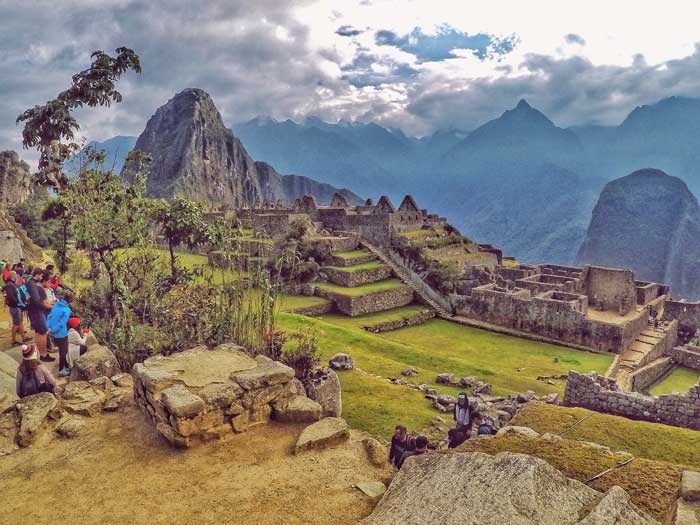
I'd suggest reading this guide on how to prepare for the Salkantay trek, but here are some points to take note:
- It is possible to do the Salkantay trek independently, but I had so much fun with my new friends I would recommend going on a tour.
- Prices for a tour range from USD $150 to over $600. I walked into the first shop along Plaza de Armas in Cusco with a sign that says: USD $165.
- Everyone in my group signed up with a different agency. My guess is that most tour packages on the lower end lump their group together, so it doesn’t really matter which agency you sign up with.
- Make sure to check what your tour includes: meals, camping equipment, transport there and back, English-speaking guides, mules to carry your bags, ziplining, Machu Picchu ticket, Machu Picchu mountain climb etc. Some group members had an extra night in Aguas Caliente and a train back and they didn’t know it. ALWAYS CHECK.
- Additional costs are: ziplining, hot spring, bus to hot spring, additional food and drinks that you buy along the way
- You can rent trekking poles and sleeping bags from the companies. Mules carry up to 5kg and that includes the sleeping bag (1-2kg). You can always pay extra for more baggage allowance.
- There is an option to climb up the Machu Picchu Mountain and Huayna Picchu (if you book in advance). It’s a steep 1hr climb up after 5 days of trekking. Know your fitness level before opting for it. I was glad I did not include it.
- Pack light! Climbing uphill with heavy bags is no laughing matter.
- Pack layers as the climate changes often and the internal heat generated makes you warm.
- Bring your passport for Machu Picchu. Note that it no longer accepts the ISIC card. Now that’s a bummer.
- You can charge your camera and mobile phones on day 4 at Aguas Caliente. There’s also wifi there.
- Lastly, know your alcohol limit. Don’t get wasted on a multi-day trek like me.
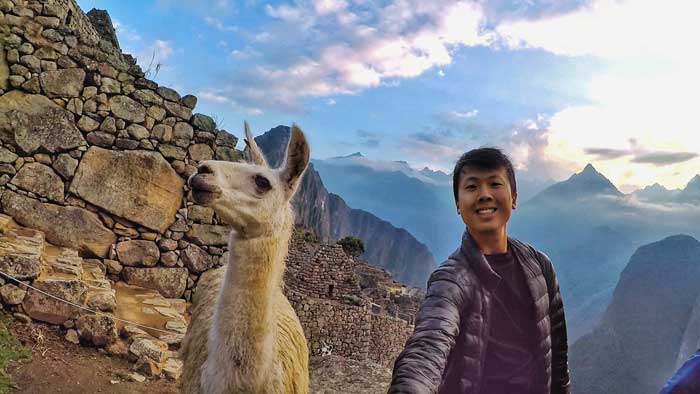
And now, it’s your turn.

